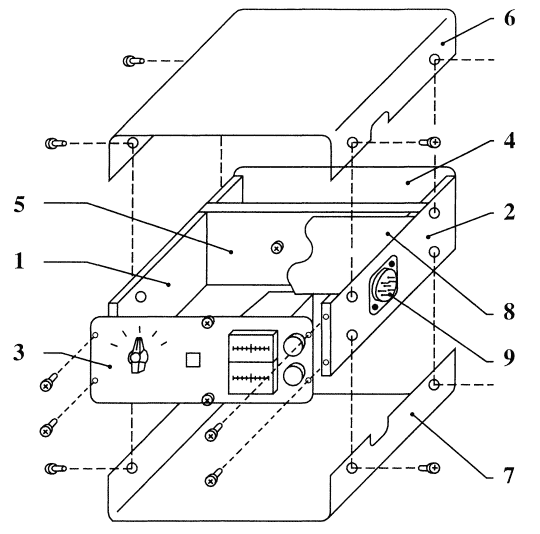In Amateur literature describes a number of successful designs different enclosures for electronic devices. Not all of them are suitable for Autonomous battery powered devices, which include the metal detectors. To the body of the detector is put forward a number of requirements: compactness, durability, secure mounting of printed circuit boards and batteries, comfortable working in field conditions. There are and specific requirements, such as having low-resistance and stable the time of contact between the massive metal body parts.
Below is described the design of General purpose enclosures suitable for "electronic components" almost any detector medium difficulty. This case is suitable for all circuits of the detectors described in the book. Author sought to create technologically advanced and simple to manufacture design of satisfying all these requirements. In Fig. 41 shows a General the view developed by the author of the universal body.

Fig. 41. Construction universal housing
The housing comprises two side walls 1 and 2 which is made of sheet aluminum alloy 4 mm thick In the sidewalls of the holes with M3 thread under the mounting screws, which fasten the other parts of the body. On the sidewall 2 is also installed connector 9 for connecting the cable of the sensor device. With inner side of the sidewall 2 has a contact lug of the enclosure-via which are connected with the common bus of the electronic part and the cable screens. This petal is clamped under the nut of one of the mounting screws on the connector 9. Metal the sidewall under the contact petal carefully trimmed. To ensure stable performance, no other contact of the enclosure with shared bus electronic parts are not allowed!
On the front panel 3 (shown in example induction metal detector) installed arrow devices, balancing potentiometers, switch operation modes and the system (from the inside). Front panel - double-layer. The outer layer is a false panel made of anodized aluminum sheet of 0.5 mm thickness black color. Engraved on it is made the necessary lines and signs. Directly the panel underneath false panels, made of sheet fiberglass thickness of 2.5 mm.
Rear panel 4 - easily removable and serves as a cover of batteries. It attaches with one screw to the threaded sleeve, is fixed to the partition 5. For ensure that the rear panel does not bend when tightening only your mounting screw, it is strengthened profile in the form of a wide channel, bent also, as a panel, sheet aluminum alloy with a thickness of 1 mm. Profile and the panel, together with four M3 screws with nuts.
The upper cover 6 and the bottom lid 7 are the main protective elements corps. The cover is made of sheet aluminum alloy with a thickness of 1 mm. On cap shape are the same and 100% mirror images of each other.
The printed circuit Board 8 of the electronic part of the device is attached to the end surfaces sidewalls 1 and 2 by means of screws screwed into threaded holes in the sidewalls. A printed circuit Board mounted parts inside the body and between her and top cover 7 there is sufficient clearance. For modifications induction metal detector for more complex devices have a threaded hole in the lower end the surfaces of the sidewalls 1 and 2 to install the optional PCB. It is set parallel to the main circuit Board 8 also details inside corps. Details on printed circuit boards are placed so as not to take the space in the locations of the pointer of the microammeter and balancing the potentiometers.
The screws MH to connect the individual parts of the body used from the set fasteners for Assembly of computers. They are reliable and beautiful chrome finish coating and shape in cross section, slightly different from the circle (i.e. it is a kind of screws), which ensures strong attachment, not razvenchivayuschie from bumps and vibration and (!) reliable electrical contact.
All aluminum parts are preferably subjected to electrochemical treatment (anodizing in bichromate), which will give them not only attractive greenish shade, but also protect against corrosion. Despite significant layer oxide on the surface of anodized aluminum, the contact between the metal the case remains reliable and stable. This is achieved the use of special screws (see above), tighten with enough force to threaded holes in the sidewalls (without oxide) and into contact with the inner the surfaces of the holes of parts (without oxide - reamed).
Author: A. I. Shchedrin






